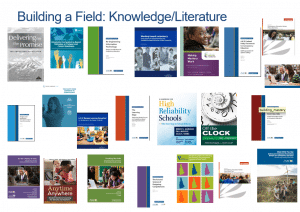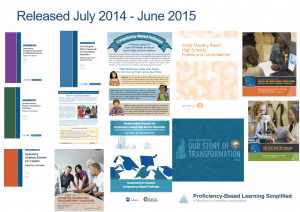A Reflection on the Field of Competency Education
CompetencyWorks Blog
 Each summer, CompetencyWorks takes a bit of time to reflect on where we have come from, accomplishments, and emerging issues. Our advisory board is absolutely instrumental in this process, helping us to understand nuances and variations across states.
Each summer, CompetencyWorks takes a bit of time to reflect on where we have come from, accomplishments, and emerging issues. Our advisory board is absolutely instrumental in this process, helping us to understand nuances and variations across states.
Below are the highlights of our discussion this year. It’s long, but I think sharing in detail is worth it, especially as each week people contact us seeking help in understanding the field. Please, please, please – we would love to hear your insights and understanding of where we have come from and what we need to think about in terms of advancing competency education. It’s the richness of multiple perspectives that allow us to be as strategic as possible.
I. How Are We Doing in Terms of Expansion?
When we wrote the first scan of the field in 2010, there were only pockets of innovation across the country, each operating in isolation. Five years later, eighteen states are actively pursuing competency education through a range of strategies including proficiency-based diplomas (ME, NH, CO, AZ), integrating competency education into the education code (VT, NH), innovation zones (KY, WI, CT), pilots (OR, IA, OH, ID), and task forces in partnership with districts (SC, WY, OK, HI, DE). Federal policymakers are now familiar with competency-based education in the K12 and higher education sector, with ESEA policy discussions considered pilots for new systems of assessments.
Districts are converting to competency education across the country, with or without state policy enabling the change. In addition to the northern New England states, which have strong state policy initiatives, districts are converting in AK, AR, CA, CO, CT, FL, GA, MI, and SC.
New school models are developing that push beyond the traditional organization of school to high levels of personalization, including those at Summit Public Schools, Building 21, Virtual Learning Academy Charter School, Boston Day and Evening Academy, Making Community Connections Charter School, EPIC North, and Bronx Arena. Schools for the Future has recently announced record-breaking results in its first year of operation.
Some people think the rate of expansion is too slow. Personally, I think we need to really “get it right” – robust competency-based structures, high levels of personalization so our most historically underserved populations of students are thriving, upgraded instruction and assessment aligned to higher levels of knowledge, and effective use of online learning – before we worry about the speed of expansion. Let’s practice what we preach. We are in the midst of huge learning as we deconstruct the traditional system and put into place a more vibrant, personalized system, and it may take us a bit of time. It took us well over 200 years to create the traditional system, and its rituals are deeply rooted into our own personal lives. I don’t think it is a problem if it takes us a few more years to get it right.
The Results from our Early Adopters: The early adopters are now three to four years into implementation (with the exception of Chugach School District, which has been using a competency-based model for nearly two decades). Many have developed the systemic framework within a traditional agrarian, course-based model, which means that at first glance, it appears there is little innovation…until one looks deeper to see the benefits of greater personalization, student agency/voice/choice, consistency of proficiency scales across the school, and greater responsiveness to students who are struggling.
The primary concern is that we have little to report out as results yet. This appears to be the result of one or more causes, varying across schools, including:
- implications of roll-out strategies;
- limitations of state accountability exams to determine growth;
- limited improvements in instruction, possibly related to continuing to use relatively traditional schedule;
- inadequate attention to habits of learning to support student agency;
- failure to embrace a framework for depth of knowledge and/or inadequate calibration;
- inadequate attention to the needs of traditionally under-served students and/or difficulty in creating opportunity for more supports/time for learning;
- humility – many of our leaders are professional learners, slow to claim success as they themselves are not fully satisfied that their schools are fully competency-based yet; and
- lack of funding for evaluation, co-designed with practitioners, including formative evaluation that would help identify the underlying issues.
Here is the list we’ve been able to pull together of results…so far.
Early Majority: In states that have set the expectation that all districts will be competency-based, we are now seeing the early majority begin the conversion process. The primary concern here is that they perceive competency education as a technical reform (scroll down mid-way in the post How Competent Are We at Competency Education for further discussion) that begins with the second stage of implementation, designing the infrastructure of learning, before investing in the ramping up stage that replaces the values and beliefs of the traditional system with those of a culture of learning and empowerment. Thus, the implementation challenges are likely to be greater and may also induce opposition from students and parents. However, given that the last four years have developed a number of teachers and principals who are familiar with competency education, we are now seeing the knowledge being transferred as people move up career ladders. This may mitigate the problems that will develop with a technical implementation of CBE.
Moving From B to C (i.e., Blended to Competency-Based): There is interest among a handful of districts that have invested heavily in establishing a strong digital infrastructure and increased personalization through blended learning to now integrate a competency-based infrastructure. This raises new opportunities and is likely to have a somewhat different implementation process. It will also likely push the vendors to consider greater transparency and design to ensure that the learning taking place online naturally leads to students demonstrating higher levels of learning and performance assessments.
II. How Are We Doing in Developing, Disseminating, and Transferring Knowledge?
 When we began in 2001, there was one book and one paper describing competency education. There are now at least thirty-three reports and the CompetencyWorks website and wiki to support policymakers and educators. Certainly there are still gaps (student agency and habits of learning, advancing beyond grade level, systems of assessments, etc.) and emerging issues raised by the field (granularity, inter-school and inter-district calibration, deeper looks at grading, information management systems, and structure of the instruction and assessment model).
When we began in 2001, there was one book and one paper describing competency education. There are now at least thirty-three reports and the CompetencyWorks website and wiki to support policymakers and educators. Certainly there are still gaps (student agency and habits of learning, advancing beyond grade level, systems of assessments, etc.) and emerging issues raised by the field (granularity, inter-school and inter-district calibration, deeper looks at grading, information management systems, and structure of the instruction and assessment model).
It is likely that other types of media or approaches would be helpful, including video, interactive reports that al low for deeper dives, and MOOCs. There is also a growing demand for greater attention to the broader systemic issues, engaging leaders in identifying and describing the type of infrastructure that needs to be in place in states.
low for deeper dives, and MOOCs. There is also a growing demand for greater attention to the broader systemic issues, engaging leaders in identifying and describing the type of infrastructure that needs to be in place in states.
The biggest challenge we have is that we continue to have limited technical assistance. As demand grows, districts are seeking networks and providers that can help them in advancing toward competency education. However, given that we haven’t seen significant achievement results yet, it is possible that technical assistance providers themselves may not know exactly what is needed to ensure that traditionally underserved students fully benefit from competency education. This once again highlights the importance of investing in evaluation that is co-designed with practitioners. In addition, developing a practitioner-informed set of promising practices or indicators for high quality implementation could be very helpful.
A last observation – right now the only place for innovators to meet each other, network, and share knowledge is at through the competency education strand at the iNACOL Symposium and through regional meetings of the Great Schools Partnership and New England Secondary School Consortium. There have been some efforts to create networks, but they are often invite-only which is frustrating for all the other districts that want access to knowledge. Thus, it may be time to think more strategically about whether more opportunity for networking and formal transfer of knowledge is needed.
III. How Are We Doing as a Field?
The number of organizations that have invested in developing their knowledge about competency education, created staff capacity, and established initiatives has continued to grow. Our estimate is that there are thirty-plus organizations playing catalytic roles in the field with an understanding of competency education as a structural change, not just as flexible pacing. Although confusion continues about the difference between flexible pacing in online learning and competency education, the leading organizations all understand the competency education is a structural change that enables greater responsiveness by schools to student needs, not just pacing.
There is now adequate capacity to support states in policy development and shaping initiatives. Certainly, more support is always welcome, but in terms of where foundation resources are directed, the greater need is to address the insufficient technical assistance support.
To date, the organizations in the field of competency education have been willing to share freely, support each other’s work, and seek out feedback from others. However, in the past six months we have been starting to hear “negatudes” about competency education itself (such as “the quality of implementation is mediocre”) and harsh critiques about other organizations in the field. It’s likely some of this is from the field becoming more crowded…and more competitive for foundation funding. However, we also believe that just as competency education requires a different style of leadership at the state and district levels, field organizations need to be able to operate with a stronger culture of learning as compared to judging. In addition, this emphasis on creating cultures of learning and greater professionalism of teachers is also changing how we think of expertise. Those that have deep expertise in narrow areas are going to be challenged to think about issues in much broader contexts than ever before. In other words, silo’d knowledge has only limited value as we embed educational knowledge in districts and schools. As a short-run strategy, we think it may be helpful to the field to have greater coordination so we can continue to seek out where there are gaps rather than have organizations competing for the same “turf.”
The greatest weakness currently in the field is the lack of diversity and attention to traditionally underserved students. At a time in which America is revisiting race, racism, and race relations, the field of competency education and the other “next gen” fields are demonstrating that in general we do not know how to develop or sustain diverse organizations – and thus are at risk of reproducing inequity ourselves.
IV. What Are the Current Issues Going Forward?
Although the list of current issues that require more clarity or are emerging is long, we have highlighted a few that we believe are crucial to moving forward:
- Diversity: We are in the process of identifying, meeting, and interviewing people of color who are in positions of leadership and/or offer substantial expertise. We are highlighting them on CompetencyWorks, and as we become familiar with their expertise, are brokering relationships so meetings and panels begin to have more diversity. We also hope that we can begin to link networks and broaden access to knowledge and perspectives. But this is just a small step toward tackling a big problem.
- Spirit of CBE: As early majority districts begin to convert, they are approaching competency education as a technical reform. Based on site visits, we do not think this will produce schools that will ensure students reach proficiency. We believe there is a process needed to shake off the old belief system and replace it with a new set of values and beliefs. The paper Implementing Competency Education in K12 Systems is our first intervention on this issue, as we spent significant portion of the paper describing the ramping up process.
- Student Agency and Habits of Learning: There is inadequate understanding and attention to what it takes to build student agency and its relationship to habits of learning. Furthermore, there is confusion about how all the so-called non-cognitive skills and traits relate to each other. We are at the beginning of this investigation and are seeking to draw upon other efforts in the field to help clarify what it takes to enable student agency.
- Performance-Based Funding is Not Part of Competency Education: Simultaneous to the expansion of competency education is interest among policymakers to performance-based funding, especially within the higher education sector. We need to make sure that performance-based funding does not invade the K12 conversation on competency education, as it is certainly going to be a wedge issue. Furthermore, until we have achieved results we do not know what it will cost to support low-income children, those with disabilities, and those learning English to college and career readiness with the full range of higher order skills. First things first – we need time to get this right.
- Preparing for Opposition: Thus far, confusion has been a bigger issue than opposition. However, there are signs that opposition, very similar in nature to the opposition to outcome-based education, is growing. We anticipate that this may increase during the presidential campaign season. Furthermore, poor quality implementation will likely trigger opposition, as well. We need to be able to learn from each other how to respond to opposition at the local level.
- Creating a Culture of Learning in the Field: As has been described above, we are worried that the way that field organizations are talking about districts and schools may actually harm us. We believe we need to nurture a new culture of learning that allows field organizations to understand and advance high quality implementation as a process rather than as a judgment.
What are the issues you think are imperative for us to address/resolve?
V. And What Does this Mean for CompetencyWorks?
Five years ago, CompetencyWorks was focused on initial field-building and creating opportunities for the voice of the innovators to shape the field.
- Creating a working definition that could bind the field together even as innovations developed.
- Supporting networks through identifying innovators, introducing them to each other at the Summit, brokering relationships, and establishing a competency education strand at the iNACOL Symposium.
- Supporting new organizations as they entered the field of competency education to understand what it is, direct them to sites to visit, and introduce them to leaders across the state.
- Identifying and developing contributing authors.
- Knowledge development and dissemination through the website, wiki, papers, and webinars.
As the field developed, our role has expanded to include:
- Describing the work of districts in more depth, identifying new models, and highlighting new districts that are implementing competency education.
- Identifying and responding to questions and emerging issues from the field. This is often done in partnership with leaders so we produce a blog they can use to address an issue they are having in their community.
- Light coordination with semi-annual phone calls to allow organizations to know what to anticipate, identify opportunities for collaboration, and reduce duplication.
- Briefings and presentations to policymakers, funders, district leaders, and organizations trying to learn about competency education.
- Providing ongoing support and feedback to other organizations, including reviewing of papers, participating in webinars as requested (panels and in chat rooms), and consultations on materials.
- Policy development and advocacy, including supporting federal policymakers involved in ESEA, testifying at state legislatures, and providing support in other ways at the state level.
- Intervening in issues that put the field at risk, including misunderstanding competency education as solely about pacing; level setting knowledge of personalization, competency-based structures, and blended learning; and protecting competency education from insertion of non-related policy items (such as performance-based funding).
However, instability in funding (that hopefully will soon be resolved) has required us to stay focused on our core mission – advancing high quality competency education by lifting up knowledge from leaders and practitioners in states, districts, and schools.
See also: